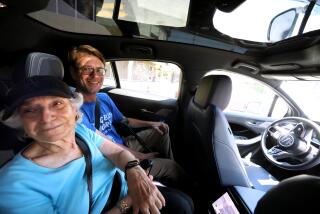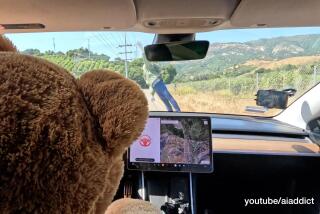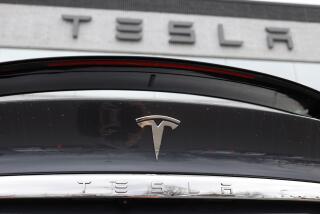CES 2014: Audi’s self-driving car -- look, Ma, no hands

Test driving an Audi driverless car.
- Share via
Driving a car is so 20th century. The future of driving is the autonomous vehicle. Or at least that was the biggest high-tech automotive trend on display at CES, the unofficial Las Vegas auto show.
This year, Audi came to the consumer electronics show with a slate-gray A7 self-driving car. We went for a joy ride in Vegas traffic to see what the new piloted technology can do.
We headed to the Cosmopolitan Hotel garage in Las Vegas, where we were greeted by Bjorn Giesler, Audi’s project leader of development of piloted driving, two additional Audis and two Nevada state troopers, who followed our car all the way to Interstate 15. In the back of the car was an Audi engineer to monitor the piloted system, in case of a glitch, and to work the radio with the police. This was reassuring.
The prototype Audi A7 test vehicle was equipped with front-facing digital cameras, laser scanner and radar system, all tied to a central computer. The sensors elegantly hidden in the grille enable the self-driving capabilities and are much more compact than the spinning contraption on the roof of Google’s autonomous cars. According to Giesler, there’s nothing on the roadway that one of these systems can’t detect.
As the car slowed to less than 40 miles per hour, the pilot system activated and began driving the Audi. The driver has the option to press a button on the wheel for the car to take over.
As soon as the driver took back the wheel, the piloted assist stopped and manual control resumed. Giesler said Audi built in redundant systems for braking, communications and power supply to ensure that the system doesn’t fail while out of the driver’s control.
As the car drove itself, other Audi cars took turns simulating traffic scenarios. For example, one car merged in front of our car, which caused ours to slow down and maintain a safe distance.
After putting the car through a few more traffic tests, the driver told me to watch the road and closed his eyes. Ten seconds later, a loud buzzing ring sounded through the cabin to get his attention.
When that didn’t work, the car automatically stopped itself in the middle of the highway and turned on its emergency signal. The logic was that when the driver is completely unresponsive, the only safe thing to do is stop. In a real-life situation, the car would also place a call to 911.
Audi brought several other high-tech car demos to CES as well. The automaker also showed off piloted parking, a new in-car tablet called Audi Smart Display, a traffic-light alert countdown system and the next-generation MMI infotainment system.
If we can get over the uncomfortable feeling of letting go, driverless cars could make getting around in congested Los Angeles less stressful.
ALSO:
Our favorite gadgets of CES 2014
Internet streaming device maker unveils the Roku TV
BMW i3 takes commands from a Galaxy Gear smartwatch






